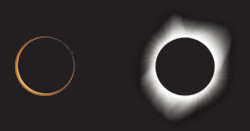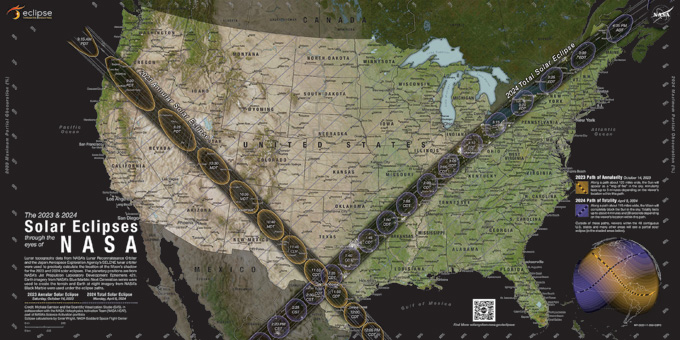Have you ever witnessed a solar eclipse? You are in luck if you live in North America! The next twelve months will see two solar eclipses darken the skies for observers in the continental United States, Mexico, and Canada!
Solar eclipse fans get a chance to witness an annular eclipse this fall. On Saturday, October 14, 2023, the Moon will move exactly in front of the Sun in a path from Oregon to Texas. Since the Moon will be at its furthest point from Earth (or apogee), it won’t completely block the Sun. Instead, the Moon will leave a dramatic “ring” around its edges, giving the name annular, which means ring-like. If you are under a tree, you will see thousands of ring-like shadows! Areas south of Moab will experience this eclipse for over two minutes! Wherever you are, be prepared with safe observation methods. Even a bit of the Sun can cause blindness.
Just six months later, on Monday, April 8, 2024, a dramatic total solar eclipse will darken the skies from Texas to Maine. While eye protection is necessary most of this eclipse, it’s not needed to witness totality, the brief time the Moon blocks the entire surface of the Sun. The Moon’s shadow will darken the skies into something resembling early evening. You will even be able to see bright stars and planets. While the darkness and chilly breeze will be a thrill, the most spectacular observation will be the Sun’s corona! For observers in the middle of the path, the eclipse will last over four minutes - twice as long as 2017’s total solar eclipse over North America.
While some folks may be lucky enough to witness both eclipses – especially in San Antonio, Texas, which lies at the crossroads – everyone can catch partial eclipses if the skies are clear. NASA has published a safety guide which can help you plan at bit.ly/nasaeclipsesafety. And, you can find a collection of solar eclipse resources from NASA at solarsystem.nasa.gov/eclipses
 Photos of an annular total solar eclipse (left) and a total solar eclipse (right). Note that the annular eclipse is shown with a dark background, as it is only safe to view with protection – you can see how a small portion of the Sun is still visible as the ring around the Moon. On the right, you can see the Sun’s wispy corona, visible only during totality itself, when the Moon completely – or totally - hides the Sun from view. A total solar eclipse is only safe to view without protection during totality itself; it is essential to protect your eyes throughout the rest of the eclipse! Credits: Left, Annular Eclipse: Stefan Seip (Oct 3, 2005). Right, Total Eclipse, NASA/Aubrey Gemignani (August 21, 2017)
Photos of an annular total solar eclipse (left) and a total solar eclipse (right). Note that the annular eclipse is shown with a dark background, as it is only safe to view with protection – you can see how a small portion of the Sun is still visible as the ring around the Moon. On the right, you can see the Sun’s wispy corona, visible only during totality itself, when the Moon completely – or totally - hides the Sun from view. A total solar eclipse is only safe to view without protection during totality itself; it is essential to protect your eyes throughout the rest of the eclipse! Credits: Left, Annular Eclipse: Stefan Seip (Oct 3, 2005). Right, Total Eclipse, NASA/Aubrey Gemignani (August 21, 2017)
